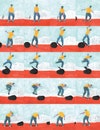Skateboarding is such an overwhelmingly visual phenomenon that words seem almost annoyingly inadequate to describe it. Even the written word struggles to do justice to its
The pain of growing up is the starting point of skateboarding, a frantic way of filling in the gaps of life, the voids of solitude and boredom. Skaters strive to master those acrobatic feats not as an end in themselves, but as a form of therapy. “I don’t want to be a spectator of my life; I don’t want to escape the suffering of growing up. I want to challenge it and see where it takes me.” Whenever they grab their boards, skaters become like Theseus venturing into the Labyrinth to hunt down the Minotaur. And just like the heroes of ancient myth, they experience an adventure made of action and vision, narrative and invention, engagement and excitement, personally facing a challenge that is both heroic and playful.
Skateboarding is rooted in a feeling of rawness, physicality and exhibitionism, hurling emotions into the street with a rough and bold attitude. At the same time, it’s a feeling that protects the frailty and insecurity of adolescence – that short yet seemingly endless stretch of life when, as Baudelaire wrote, things lack appeal if they are not slightly distorted. And skating is the distorting mirror of this reality. Despite the clichés of glossy magazines, in the last part of the 20th century this different and extraordinary form of secular devotion spawned an inevitably mutant subculture, without false tar- gets or false movements. A form of style on four wheels, it unhitched itself from the real world and its ruthless mechanisms. The skateboard became a conduit for a river of desires, a concentration of exhilaration and intense emotions to alleviate the distress of growing up.
Skateboarding doesn’t arise from a need to rebel, but from a mystical, biological urge, a desire for friendship, brotherhood and solidarity. Here we are, all in the street, a space that becomes a cavern, a den, a refuge and no man’s land. What is youth if not a people, a world developing its own values, disvalues, likes and dislikes through its subcultures and its own communication system, which aims to break with the patterns set by the previous generation?
Unsurprisingly, skateboarding perfectly overlaps with some of the fundamental themes of British punk: a rebellious attitude towards fashions of the market, a lifestyle of irreverence for social protocol, and a do-it-yourself culture that allows you to be the protagonist without the need for anything or anyone else.
It all started with surfing. What are you supposed to do when there are no waves breaking against the Californian coast? One day, while gazing at the calm sea from the top of a concrete-covered hill, a Los Angeles surfer had an idea. After a few hours in the garage tinkering with planks of wood and wheels, he rode his improvised skateboard down the hillside and the waves were replaced by the biggest playground ever seen: the concrete streets and sidewalks. A younger son of surfing, skateboarding developed in the late 1950s as a form of training for surfers suffering from withdrawal symptoms when the sea was flat. The turning point came in 1976, when drought left Los Angeles without water. The mayor introduced a hosepipe ban and for a whole summer thousands of swimming pools were left dry, but not unused. Those smooth, empty, U-shaped spaces were promptly repurposed as bowls for the skaters’ most daring tricks. It was the period when the first big names in skateboarding began to emerge: Tony Alva, Jay Adams and Stacy Peralta. They went down in history as the Z-Boys. Surfers turned skaters, they were the first to attack the sidewalks, flights of steps, railings and the ramps of road junctions, thereby bringing the art of skating to the general public. During the 1970s, a distinctive culture began to grow up around skateboarding. The ethos is summed up in a line from the cult documentary film Dogtown: “Surfing set the rules of skateboarding. Skateboarding changed the rules of life.” Its popularity was due to a singularity: it had no rules to stick to, no coaches to obey, and no playing fields or teams to be confined in.
(Continues)
This is an extract from cultural commentator and skate historian Roberto D’Agostino’s lecture Tracks on the Sidewalk, which he gave on January 31 2021 at Milan’sTriennale, as part of an exhibition and installation featuring OooOoO, a skatepark created by the South Korean artist Koo Jeong A.
Frames from rotoscoping animation painted by hand by Leon Washere. Photos by Pepe Martinez (RIP) at Pulaski Park in Washington, D.C. and Fred Gall at Love Park in Philadelphia, PA., both © Leon Washere.

